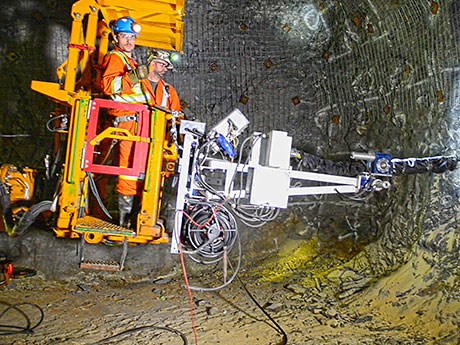A remote loading solution developed by TesMan, a Sudbury-based technology developer, is expected to hit the market by August or September.
Development of the solution began in 2012 following the death of Vale miner Stephen Perry, 47, who was struck by a 14-tonne wedge of rock that dislodged from the face on the 4,215-foot level at Coleman Mine.
Determined to avoid similar fatalities in the future, Coleman’s Joint Health and Safety Committee asked TesMan to develop a solution that would allow development miners to clean and load blastholes from a distance.
A prototype in operation at Coleman since last June keeps the operator 14 to 15 feet back from the face and a commercial version that will complete the cleaning and loading as efficiently, or slightly faster than the traditional manual method is in the final stages of development, said Rod Steele, co-owner of TesMan.
Funding for the development of the remote loading solution has been provided by Vale, Glencore’s Sudbury Integrated Nickel Operations and the Northern Ontario Heritage Fund Corporation.
Steele likens the solution to a “Swiss Army knife” with a set of tools that are fed into the holes from a distance. There’s an air hose to blow out moisture and loose debris, a hammer tool to break up any obstructions, an endoscope that allows the operator to see inside the hole, and an auger to clean out the lifters and kneeholes, which are holes at the bottom of the face that tend to get covered in material.
The tools are inserted into a feed unit and along a boom to the face using joysticks and a touch screen.
“If the hole is relatively clean, the air hose will suffice to blow the water out,” said Steele. “With the camera, the operator will see a button at the end of the hole. If there’s a chunk of rock blocking it, he can use the impact tool to push it to the back of the hole.”
He can also tell if the hole was drilled short and use timing to compensate when it comes time to blast.
In a typical six-metre by six-metre development heading, said Steele, there are 99 two-inch diameter holes drilled to a depth of 14-½ to 15 feet.
TesMan began the R&D process in 2012 with a gap analysis, but couldn’t find any existing technology for cleaning small, horizontal boreholes in development tunnels. A former Inco supervisor, Steele then spent three months underground at Coleman mapping out the conditions inside the holes to identify the tools required to prep them.
Developing a technology solution for remote loading seemed like “a long shot” at the beginning, said Coleman Mine operations manager Chris Bamberger. “The principal obstacle was our ability to believe it could happen, so we thought, let’s first see if we can remotely load a face from six feet away and go from there.”
The Coleman team was impressed with the prototype, but saw a need for several improvements.
“It definitely needs to be more robust,” said worker safety rep Craig Allair. “Also, speed is an issue. Traditionally in mining, new technology is developed for production purposes. This technology was developed for safety reasons, but in order for it to move forward, it’s going to have to be at least equal to or better than our current methods (in terms of its impact on the cycle time).”
The technology could also offer some side benefits.
“Because we’re able to measure the holes and clear any obstructions, there’s an opportunity to improve our break, but that’s still to be proven,” said Allair. “Without being able to see the back of the hole, the production person will just load it and, if it’s short, we end up with a bootleg, leaving overburden there that doesn’t break.
“If you multiply that by the number of rounds we drill and blast and the amount of overburden left behind – it could be six inches or 24 inches – that would potentially add up to increased productivity.”
The screening and bolting of development faces, mandated by Vale in 2012 to protect workers, will continue even after the remote loading solution is deployed despite the impact on cycle times and the issue with scrap steel being introduced into the material handling process.
“Bolting and screening the face is a key control for anyone working in the high-risk zone,” said Bamberger. “Initially, the remote loading project was intended to protect the person loading the face, but we have since realized through a series of detailed risk assessments that we have workers doing a number of other tasks who would not be protected by remote loading.
Getting buy-in for bolting and screening the face was a challenge – “a culture change,” said Bamberger, “but if you speak to most miners today, they would say ‘I can’t believe I used to approach the face without it being bolted and screened.’”
Glencore’s Sudbury Integrated Nickel Operations co-funded the R&D effort “because we have the same issues that Vale has, especially at depth where the stresses are higher and workers are more susceptible to bursts at the face,” said Tom Guse, infrastructure lead for the company’s Onaping Deep project.
A rich orebody below Glencore’s Craig Mine, Onaping Deep will bottom out at 2,700 metres underground and require one or two winzes from Craig Mine workings at the 1,200-metre level.
“If the remote loading solution can prove itself, I think it’s definitely something we would consider, not only for our deep mines, but also for our current depths,” said Guse.
TesMan plans to look after manufacturing the loading system, but has partnered with Industrial Fabrication, a Sudbury-based manufacturer of underground utility vehicles, to market the technology globally.



